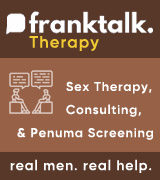Shockwave Treatment of Erectile Dysfunction – Therapeutic Advances in Urology 2013
Ilan Gruenwald, Boaz Appel, Noam D. Kitrey and Yoram Vardi
(Therapeutic Advances in Urology, April 2013 vol. 5 no. 2 95-99)
Low-intensity extracorporeal shock wave therapy (LI-ESWT) is a novel modality that has recently been developed for treating erectile dysfunction (ED). Unlike other current treatment options for ED, all of which are palliative in nature, LI-ESWT is unique in that it aims to restore the erectile mechanism in order to enable natural or spontaneous erections.Results from basic science experiments have provided evidence that LI-ESWT induces cellular microtrauma, which in turn stimulates the release of angiogenic factors and the subsequent neovascularization of the treated tissue. Extracorporeal shock wave therapy (ESWT) has been clinically investigated and applied in several medical fields with various degrees of success. High-intensity shock wave therapy is used for lithotripsy because of its focused mechanical destructive nature, and medium-intensity shock waves have been shown to have anti-inflammatory properties and are used for treating a wide array of orthopedic conditions, such as non-union fractures, tendonitis, and bursitis. In contrast, LI-ESWT has angiogenetic properties and is therefore used in the management of chronic wounds, peripheral neuropathy, and in cardiac neovascularization. As a result of these characteristics we initiated a series of experiments evaluating the effect of LI-ESWT on the cavernosal tissue of patients with vasculogenic ED. The results of our studies, which also included a double-blind randomized control trial, confirm that LI-ESWT generates a significant clinical improvement of erectile function and a significant improvement in penile hemodynamics without any adverse effects. Although further extensive research is needed, LI-ESWT may create a new standard of care for men with vasculogenic ED.
Read the abstract
Does Low Intensity Extracorporeal Shock Wave Therapy Have a Physiological Effect on Erectile Function? Short-Term Results of a Randomized, Double-Blind, Sham Controlled Study
Does Low Intensity Extracorporeal Shock Wave Therapy Have a Physiological Effect on Erectile Function? Short-Term Results of a Randomized, Double-Blind, Sham Controlled Study
THE JOURNAL OF UROLOGY, Vol. 187, 1769-1775, May 2012
By Yoram Vardi, Boaz Appel, Amichai Kilchevsky, Ilan Gruenwald
Purpose
We investigated the clinical and physiological effect of low intensity extracorporeal shock wave therapy on men with organic erectile dysfunction who are phosphodiesterase type 5 inhibitor responders.
Materials and Methods
After a 1-month phosphodiesterase type 5 inhibitor washout period, 67 men were randomized in a 2:1 ratio to receive 12 sessions of low intensity extracorporeal shock wave therapy or sham therapy. Erectile function and penile hemodynamics were assessed before the first treatment (visit 1) and 1 month after the final treatment (followup 1) using validated sexual function questionnaires and venoocclusive strain gauge plethysmography.
Results
Clinically we found a significantly greater increase in the International Index of Erectile Function-Erectile Function domain score from visit 1 to followup 1 in the treated group than in the sham treated group (mean ± SEM 6.7 ± 0.9 vs 3.0 ± 1.4, p = 0.0322). There were 19 men in the treated group who were initially unable to achieve erections hard enough for penetration (Erection Hardness Score 2 or less) who were able to achieve erections sufficiently firm for penetration (Erection Hardness Score 3 or greater) after low intensity extracorporeal shock wave therapy, compared to none in the sham group. Physiologically penile hemodynamics significantly improved in the treated group but not in the sham group (maximal post-ischemic penile blood flow 8.2 vs 0.1 ml per minute per dl, p <0.0001). None of the men experienced discomfort or reported any adverse effects from the treatment.
Conclusions
This is the first randomized, double-blind, sham controlled study to our knowledge that shows that low intensity extracorporeal shock wave therapy has a positive short-term clinical and physiological effect on the erectile function of men who respond to oral phosphodiesterase type 5 inhibitor therapy. The feasibility and tolerability of this treatment, coupled with its potential rehabilitative characteristics, make it an attractive new therapeutic option for men with erectile dysfunction.
Read Full Article
FAQ (patients / professional)
Looking for new treatment info back up
-
hoosierphilly
- Posts: 132
- Joined: Mon Mar 14, 2011 11:08 am
-
newly1
- Posts: 131
- Joined: Fri May 13, 2011 5:19 pm
Re: Looking for new treatment info back up
is there any way to increase sensitivity in the head of the dick?
-
hoosierphilly
- Posts: 132
- Joined: Mon Mar 14, 2011 11:08 am
Re: Looking for new treatment info back up
Early Onset ED and Abnormal Cavernosal Arterial Inflow as in Medscape Multifunctionality
Therapeutic Advances in Urology
Shockwave Treatment of Erectile Dysfunction
Ilan Gruenwald, MD, Boaz Appel, MD, Noam D. Kitrey, MD, Yoram Vardi, MD, PhD
Disclosures
Ther Adv Urol. 2013;5(2):95-99.
Print
Abstract and Introduction
Background
LI-ESWT in Vitro and Animal Studies
LI-ESWT for Cardiac Disease
LI-ESWT for ED
Discussion
Conclusions
References
Topic Alert
Personal Alert
Receive an email from Medscape whenever new articles on this topic are available.
Personal Alert Add Erectile Dysfunction to My Topic Alert
LI-ESWT for ED
Since one of the underlying functional causes of ED is poor cavernosal arterial blood flow, we hypothesized that inducing neovascularization by LI-ESWT could potentially improve cavernosal arterial flow which in turn would improve erectile function. If this hypothesis could be proved, LI-ESWT could then become an effective and noninvasive treatment for ED.
The purpose of our first study was to evaluate the feasibility, efficacy, and safety of LI-ESWT in 20 men, aged 56.1 ± 10.7 years, with mild to moderate ED due to cardiovascular disease and without any neurogenic etiology [Vardi et al. 2010]. These patients had ED for almost 3 years (average), and all were able to function sexually with the use of PDE5i (i.e. PDE5i responders). Our treatment protocol was based on the described methodology used in cardiac LI-ESWT [Kikuchi et al. 2010], with modifications according to the depth of the target tissue (corpora) and to anatomical differences. We applied 300 SWs (energy intensity of 0.09 mJ/mm2) to each of five different sites: three along the penile shaft and two at the crural level. The protocol consisted of two treatment sessions per week for 3 weeks, a 3-week no-treatment interval, and a second 3-week treatment period of two treatment sessions per week.
One month after LI-ESWT, the erectile function in 15 men improved. An increase by more than five points in the International Index of Erectile Function - Erectile Function (IIEF-EF) domain score was noted in 14 men, and by more than 10 points in 7 men. Five men did not respond to LI-ESWT. Overall, the average increase in the IIEF-EF domain scores was 7.4 points (13.5–20.9, p = 0.001). Furthermore, erectile function and penile blood flow were measured using nocturnal penile tumescence (NPT) and venous occlusion plethysmography of the penis, respectively. LI-ESWT improved all NPT parameters, especially in the 15 men who responded to LI-ESWT, where significant increases in the duration of the erections and penile rigidity were recorded. Penile blood flow also improved significantly and a strong correlation was found between the increase in the IIEF-EF domain scores and the improvement in penile blood flow at the 1-month follow-up examination. At the 6-month follow-up visit, 10 men reported that they still had spontaneous erections that were sufficient for penetration and did not require PDE5i support.
In view of these very successful preliminary results, the effect of LI-ESWT was further investigated in a group of men whose ED was more severe than that of the first group of study patients [Gruenwald et al. 2012]. The average initial IIEF-EF domain score of the 29 men who were recruited for this second study was 8.8 ± 1. All 29 men had not responded to oral PDE5i therapy, and had multiple cardiovascular risk factors (23), cardiovascular disease (11), and diabetes mellitus (14). The specific aim of this second study was to investigate the ability of LI-ESWT to convert nonresponders to PDE5i therapy to PDE5i responders, so that they were able to achieve vaginal penetration with oral PDE5i therapy. The results were comparable to the first study. Three months after the completion of the LI-ESWT protocol, the IIEF-EF domain scores improved by at least five points in 22 men (76%) and the mean IIEF-EF domain score increased by 10 points (to 18.8 ± 1, p < 0.0001). At the end of the study, eight men (28%) achieved normal erections (IIEF-EF domain score greater than 25) and 21 of the 29 men were able to achieve vaginal penetration with oral PDE5i therapy. Overall, 21 men (72%) were converted to PDE5i responders. Cavernosal blood flow and penile endothelial function, as measured again by venous occlusion plethysmography of the penis (flow-mediated dilatation techniques [FMDs]), were both found to be significantly improved (p = 0.0001) in the men who responded to LI-ESWT.
In both studies, a strong and significant correlation between the subjective assessment of sexual function using validated sexual function questionnaires and the objective results of penile blood flow and erectile function was found. Moreover, none of the men in both studies reported treatment-associated pain or any adverse events during or after the treatment.
The encouraging results from these two studies led us to conduct a prospective, randomized, double-blind, sham-controlled study on 60 men with ED [Vardi et al. 2012]. In this study, we investigated the effects of LI-ESWT on erectile function and penile blood flow using the identical treatment protocol and study parameters that were used in our previous two studies. For the sham-treatment, we used a probe which did not produce any SW energy but looked identical to the treatment probe and produced the same noise and feeling of a 'hit'. The demographic characteristics and the baseline mean IIEF-EF scores of the treated and sham-treated patients of this third study were similar. We found that mean IIEF-EF domain scores of the treated men were significantly higher than those of the sham-treated men. This increase in the IIEF-EF domain scores was also accompanied by improvements in cavernosal blood flows and penile endothelial function, as measured by venous occlusion plethysmography of the penis (FMD). We have been following most of these men for more than 2 years and they all report that the beneficial response that was achieved immediately after therapy has not waned (Table 1).
Therapeutic Advances in Urology
Shockwave Treatment of Erectile Dysfunction
Ilan Gruenwald, MD, Boaz Appel, MD, Noam D. Kitrey, MD, Yoram Vardi, MD, PhD
Disclosures
Ther Adv Urol. 2013;5(2):95-99.
Abstract and Introduction
Background
LI-ESWT in Vitro and Animal Studies
LI-ESWT for Cardiac Disease
LI-ESWT for ED
Discussion
Conclusions
References
Topic Alert
Personal Alert
Receive an email from Medscape whenever new articles on this topic are available.
Personal Alert Add Erectile Dysfunction to My Topic Alert
LI-ESWT for ED
Since one of the underlying functional causes of ED is poor cavernosal arterial blood flow, we hypothesized that inducing neovascularization by LI-ESWT could potentially improve cavernosal arterial flow which in turn would improve erectile function. If this hypothesis could be proved, LI-ESWT could then become an effective and noninvasive treatment for ED.
The purpose of our first study was to evaluate the feasibility, efficacy, and safety of LI-ESWT in 20 men, aged 56.1 ± 10.7 years, with mild to moderate ED due to cardiovascular disease and without any neurogenic etiology [Vardi et al. 2010]. These patients had ED for almost 3 years (average), and all were able to function sexually with the use of PDE5i (i.e. PDE5i responders). Our treatment protocol was based on the described methodology used in cardiac LI-ESWT [Kikuchi et al. 2010], with modifications according to the depth of the target tissue (corpora) and to anatomical differences. We applied 300 SWs (energy intensity of 0.09 mJ/mm2) to each of five different sites: three along the penile shaft and two at the crural level. The protocol consisted of two treatment sessions per week for 3 weeks, a 3-week no-treatment interval, and a second 3-week treatment period of two treatment sessions per week.
One month after LI-ESWT, the erectile function in 15 men improved. An increase by more than five points in the International Index of Erectile Function - Erectile Function (IIEF-EF) domain score was noted in 14 men, and by more than 10 points in 7 men. Five men did not respond to LI-ESWT. Overall, the average increase in the IIEF-EF domain scores was 7.4 points (13.5–20.9, p = 0.001). Furthermore, erectile function and penile blood flow were measured using nocturnal penile tumescence (NPT) and venous occlusion plethysmography of the penis, respectively. LI-ESWT improved all NPT parameters, especially in the 15 men who responded to LI-ESWT, where significant increases in the duration of the erections and penile rigidity were recorded. Penile blood flow also improved significantly and a strong correlation was found between the increase in the IIEF-EF domain scores and the improvement in penile blood flow at the 1-month follow-up examination. At the 6-month follow-up visit, 10 men reported that they still had spontaneous erections that were sufficient for penetration and did not require PDE5i support.
In view of these very successful preliminary results, the effect of LI-ESWT was further investigated in a group of men whose ED was more severe than that of the first group of study patients [Gruenwald et al. 2012]. The average initial IIEF-EF domain score of the 29 men who were recruited for this second study was 8.8 ± 1. All 29 men had not responded to oral PDE5i therapy, and had multiple cardiovascular risk factors (23), cardiovascular disease (11), and diabetes mellitus (14). The specific aim of this second study was to investigate the ability of LI-ESWT to convert nonresponders to PDE5i therapy to PDE5i responders, so that they were able to achieve vaginal penetration with oral PDE5i therapy. The results were comparable to the first study. Three months after the completion of the LI-ESWT protocol, the IIEF-EF domain scores improved by at least five points in 22 men (76%) and the mean IIEF-EF domain score increased by 10 points (to 18.8 ± 1, p < 0.0001). At the end of the study, eight men (28%) achieved normal erections (IIEF-EF domain score greater than 25) and 21 of the 29 men were able to achieve vaginal penetration with oral PDE5i therapy. Overall, 21 men (72%) were converted to PDE5i responders. Cavernosal blood flow and penile endothelial function, as measured again by venous occlusion plethysmography of the penis (flow-mediated dilatation techniques [FMDs]), were both found to be significantly improved (p = 0.0001) in the men who responded to LI-ESWT.
In both studies, a strong and significant correlation between the subjective assessment of sexual function using validated sexual function questionnaires and the objective results of penile blood flow and erectile function was found. Moreover, none of the men in both studies reported treatment-associated pain or any adverse events during or after the treatment.
The encouraging results from these two studies led us to conduct a prospective, randomized, double-blind, sham-controlled study on 60 men with ED [Vardi et al. 2012]. In this study, we investigated the effects of LI-ESWT on erectile function and penile blood flow using the identical treatment protocol and study parameters that were used in our previous two studies. For the sham-treatment, we used a probe which did not produce any SW energy but looked identical to the treatment probe and produced the same noise and feeling of a 'hit'. The demographic characteristics and the baseline mean IIEF-EF scores of the treated and sham-treated patients of this third study were similar. We found that mean IIEF-EF domain scores of the treated men were significantly higher than those of the sham-treated men. This increase in the IIEF-EF domain scores was also accompanied by improvements in cavernosal blood flows and penile endothelial function, as measured by venous occlusion plethysmography of the penis (FMD). We have been following most of these men for more than 2 years and they all report that the beneficial response that was achieved immediately after therapy has not waned (Table 1).
Return to “General Discussion”
Who is online
Users browsing this forum: No registered users and 44 guests








